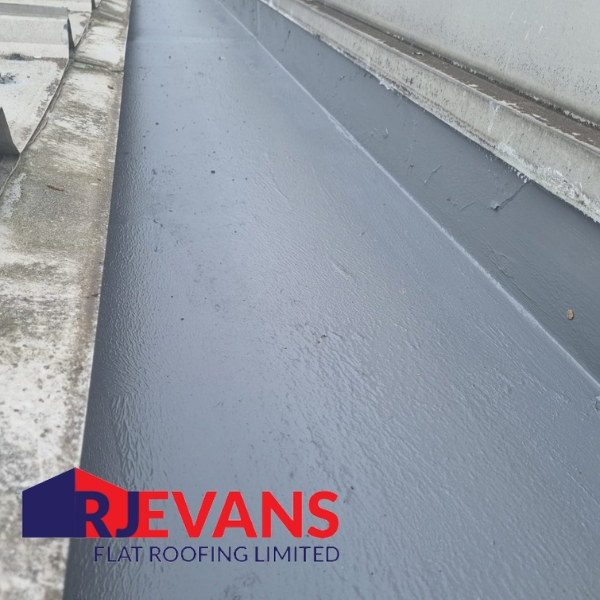I agree Our site saves small pieces of text information (cookies) on your device in order to deliver better content and for statistical purposes. You can disable the usage of cookies by changing the settings of your browser. By browsing our website without changing the browser settings you grant us permission to store that information on your device.

If you have a flat roof, you will need guttering. The purpose of guttering is to let rainwater drain from the roof surface and prevent pooling. While most modern flat roofs have a slight slope and are installed with a membrane to prevent water leaks, guttering is still an important part of the roof design. Without the proper guttering installed a flat roof can suffer from a shortened life expectancy.
Rainwater should not at any point begin to build up on your flat roof. If it does, it indicates poor flat roof construction. The ideal result is for any water to drain quickly as it lands on the roof covering. This process is essential when the temperature is 32℉ (0℃) or below, as any standing water will begin to freeze at these temperatures.
Flat roofing should be constructed with the necessary drop to allow for the correct runoff (2). This runoff will lead the water into the gutters. While you may still see some pooling, it will be insignificant and not lead to freezing conditions which harm the roof and potentially other parts of your property.
When selecting the gutter system for your flat roof, it should have all the necessary parts: gutters, downpipes, and rainwater outlets. There should be both primary and secondary rainwater outlets for optimal performance, as they will function in an emergency.
When the flat roof rests below a steep roof, metal flashing can be used with tiles placed over the flashing. Roof drains with strainers are an excellent addition to trapping debris and preventing clogs.
Common gutter systems use vinyl, aluminium, steel, and copper. Liquid coatings can be applied to these systems to optimise the drainage system.
Vinyl gutters are great for a DIY home improvement project. They will not rust or rot, but their major downside is they can warp and split due to exposure to the elements and extreme temperatures.
Aluminium is a fantastic option as it comes in many colors and resists rust. Galvanised steel is not generally rated for a DIY project, so you will generally need a professional for installation. It requires soldering, special tools, and materials that many homeowners do not have. The downside to this material is that it requires routine maintenance and is prone to rust (1).
Copper gutters it requires very little maintenance. The main requirement you will have to take care of is routine cleanings to keep these gutters free-flowing.
One of the best solutions is to install gutters which are seamless. However, you will not be able to install these yourself. They are custom fit to your home onsite with a special portable machine. An excellent way to ensure a seamless waterproof coating on a guttering system with joints, is to make use of a gutter lining using cold applied liquid waterproofing.
Such a system will encapsulate the gutter in a single waterproof coating. This is a great way to maximise the lifespan of any drainage system. A gutter lining can be installed at any stage in the lifespan of a gutter and can even be used to repair a failing gutter.
Ensure you are wearing protective clothing and eyewear before you start this project. Start by measuring your roof to decide the exact location of your downspouts. Using a saw, cut the gutters.
Put the gutters together on the ground with a two-inch overlap. At each overlap, drill six evenly spaced holes. They should be ⅛-inch and a fraction from the edge. Using a rivet gun, put in and secure rivets in the holes.
Seal the underside of each gutter section with a caulk gun. Cut the downspout outlet holes using tin snips, then line them with gutter sealant.
You’ll need to measure the gutter length and calculate the slope. Typically, this is a ¼-inch allowance per 10 feet of gutter. Mark this with a pencil, fixing the gutter to the sloped line. Using hook hangers, screw them into the fascia boards approximately every 18 inches.
The downspouts should be installed in the outlets. You must attach them to the side of the house with the hangers. Seal them with gutter sealant to achieve a waterproof fit.
For cavity walls, fit cavity trays with weep holes. Upstands and waterproof membranes also need to be fit to prevent water seepage. Flashing can create a waterproof joint when it covers the membrane.
You must keep your gutters clean to keep everything fully functional, even if you use the best materials for your gutter, a build up of debris will cause blockages. If your system backs up with water due to a blockage, this will cause excessive problems, including pulling the gutters from your property, rotting the fascia, and damaging the foundation. If you’re not comfortable cleaning them yourself, you can always hire a professional company to handle the job.
Although it may seem a small detail on a flat roof. A flat roofing system is dependent on guttering to ensure proper drainage. Maintaining your gutters is of particular importance to ensure your flat roof lasts for at least its full life expectancy.
We hope this blog post has helped you understand more about guttering for flat roofing. If you would like a quote for any upcoming project or any more information about flat roof guttering, you can contact us on 01277 375 511 or get in touch via our contact form. One of our friendly team of experts will be delighted to help.